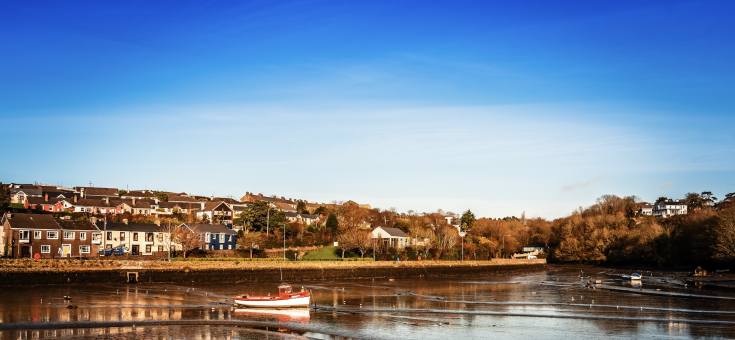MATCH-UP: Exploring the 10-Minute Town Framework

A largely rural and geographically fragmented area, the southern region of Ireland is highly reliant on private cars for transport, with emissions rising year on year.
“Transport emissions account for 20% of Ireland’s emissions and increased by 136% between 1990 and 2019 compared to an EU average of 20%,” explained Rose Power, EU Projects Officer at Ireland’s Southern Regional Assembly (SRA) – or, Tionól Réigiúnach an Deiscirt. “The population of the Southern Region is predicted to grow by 23% by 2040 so we need new and innovative solutions if we are to achieve our target to reduce Ireland’s emissions by 51% by 2030”
The SRA, comprised of three strategic planning areas and ten local authorities, is responsible for supporting coordination and cooperation between local authorities and forging links with the national and European levels. In addition, SRA is the Managing Authority for the Southern & Eastern Regional Operational Programme (SER-OP) 2014-2020 and has responsibility for the implementation of the Regional Spatial and Economic Strategy (RSES) for the Southern Region.
In response to rising emissions, the SRA noted a need for gateways and hubs, to increase the use of public and active transport and reduce the number of private car journeys take. Specifically, the SRA considered expanding the networks of cycle and bus lanes, improving information provision, and further developing walking and cycling access to public transport. It would achieve these goals by making use of resources from the SER-OP 2014-2020 and creating an implementation tool for the RSES.
Key lessons for Southern Ireland
By participating in the MATCH-UP project, the SRA was seeking to find inspiration and solutions that had worked in other regions and transfer them to their own communities. The project, comprised of five partners from Ireland, Italy, Germany, Portugal and Romania, has explored low-carbon strategies in different types of territory, looking in particular at multimodal urban mobility. Partners exchanged experiences and good practices and engaged with their regional stakeholders to find solutions that could work in their regional context.
The SRA took particular interest in four good practices from Funchal, Madeira (Portugal) and the County of Northeim (Germany)
- Intelligent Crossroads (Funchal), using an ICT system and LEDs along a pedestrian crossing for road safety, powered by renewable energy;
- Boosting Multi-Modality (Funchal), in which several measures have been implemented to improve the pedestrian network and create pedestrian zones;
-
(Northeim), a rail connection closed since 1984, re-opened a reinforced with regional bus services;Document
-
(Northeim), an on-demand bus service for those of limited mobility.Document
“In particular, we were inspired by the revitalisation of the Ilimebahn, with partners from Northeim providing us with details of the comparative analysis and viability assessment framework for this good practice, which placed a significant emphasis on linking transport and spatial planning,” said Power.
As a result of these exchanges, the SRA produced an Action Plan to implement lessons learned into both the SER-OP and the RSES, including an action to create a new implementation tool for the RSES – the 10 Minute City & Town.
10 Minute City & Town
Under the RSES, the SRA Project Officer for the Interreg Europe MATCH-UP Project, the SRA Regional Planning Team and the transport consultants Arup have developed a framework and methodology for implementing the '10 Minute Town' concept, seeking to ensure all daily necessities, community facilities and services are provided within a 10-minute walk or cycle, or are accessible from rural settlements by high-quality public transport services.
The methodology involves four main steps:
- Data collection and validation, identifying street networks and community facilities (such as healthcare, education, retail, and leisure);
- Wider public transport connectivity analysis, determining where pedestrians and cyclists can travel through the street network, and establishing 5-10 minute catchment areas for main facilities
- Understanding baseline conditions, including constraints (lack of connectivity and poor active transport infrastructure), demographics and travel patterns;
- Identifying opportunities, considering new routes and connections.
The results of the methodology can be used, therefore, to plan new actions which can increase accessibility to essential services.
Implementation in key towns
The methodology was pilot tested in three key towns in the Southern Region – Carlow, Tralee and Ennis – to ensure it was robust as it was to be used to integrate the concept into Local Development Plans for all 14 of the region’s key towns. This implementation tool was approved by the Elected Members of the Assembly in September 2020 and by the SER-OP Monitoring Committee in April 2021. To support integration, the Southern Regional Assembly will be holding an event on 31st January 2022 for all local authorities and transport stakeholders in the region. Following this event, the SRA will establish three smaller working groups to help Local Authorities to embed the practice into their Local Development Plans and Local Transport Plans.
“It was originally envisaged that this implementation tool would only be used for our 14 key towns but now the plan is that it will also be implemented by the 3 cities in the Southern Region,” explained Power. “The 10 Minute City & Towns implementation tool will assist compact growth, reduce air pollution, emissions, and traffic congestion. It embeds sustainable mobility strategies into our policy instruments while encouraging a more active lifestyle, improving placemaking and quality of life for all citizens.”
Further impact is expected nationwide, as the national Department of Transport is interested in rolling this event out to all regions of Ireland, and SRA has been asked to produce a section for inclusion in the National Sustainable Mobility Policy for Ireland.
For more information, see the Publication: 10 Minute Towns: Accessibility & Framework Report, or view the Presentation: 10 Minute Towns Model.
